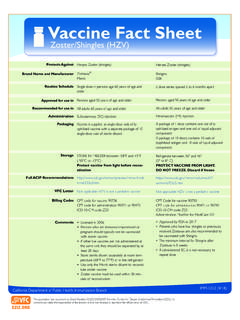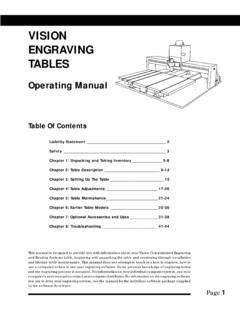Transcription of The art of probability-of-default curve calibration - arXiv
1 The art of probability -of- default curvecalibrationDirk Tasche First version: December 15, 2012 This version: November 26, 2013PD curve calibration refers to the transformation of a set of rating grade level prob-abilities of default (PDs) to another average PD level that is determined by a changeof the underlying portfolio-wide PD. This paper presents a framework that allowsto explore a variety of calibration approaches and the conditions under which theyare fit for purpose. We test the approaches discussed by applying them to publiclyavailable datasets of agency rating and default statistics that can be considered typ-ical for the scope of application of the approaches. We show that the popular scaledPDs approach is theoretically questionable and identify an alternative calibrationapproach ( scaled likelihood ratio ) that is both theoretically sound and performsbetter on the test : probability of default , calibration , likelihood ratio, Bayes formula, rat-ing profile, binary IntroductionThe best way to understand the subject of this paper is to have a glance at table 1 on page 2that illustrates the problem studied.
2 Table 1 shows the grade-level and portfolio-wide defaultrates (third column) that were observed in 2009 for S&P-rated corporate entities together withthe rating frequencies that were observed at the beginning of 2009 (second column) and at thebeginning of 2010 (fourth column). The question marks in the fifth column indicate the questionthis paper is intended to answer: How can grade-level default rates for a future time period beforecast on the basis of observations from an earlier period and the known rating profile at thebeginning of the future period? E-mail: author currently works at the Prudential Regulation Authority (a division of the Bank of England). Theopinions expressed in this paper are those of the author and do not necessarily reflect views of the Bank author is grateful to two anonymous referees whose suggestions significantly improved the [ ] 26 Nov 2013 Table 1: S&P rating frequencies (%) and default rates (%) in 2009 and rating frequencies in2010.
3 Sources: S&P (2010), tables 51 to 53, and S&P (2011), tables 50 to rateFrequencyDefault + + + + + question mark in the lower right corner of table 1 indicates that we investigate this questionboth under the assumption that an independent forecast of the future portfolio-wide defaultrate is known and under the assumption that also the future portfolio-wide default rate has tobe call a forecast of grade-level default rates aPD problem we study in this paperis made more complicated by the fact that for economic reasons PD curves are subject to theconstraints that they need to be monotonic and positive although table 1 shows that this isnot necessarily true for empirically observed default scope of the concepts and approaches described in
4 This paper is not limited to data fromrating agencies but covers any rating system for which data from anestimation periodis avail-able. It should, however, be noted that the focus in this paper is on grade-level default rateforecasts while the problem of forecasting the unconditional (or portfolio-wide) default rate isnot considered. Forecasting the unconditional default rate is an econometric problem that isbeyond the scope of this paper (see Engelmann and Porath, 2012, for an example of how toapproach this problem).This paper appears to be almost unique in that it solely deals with the calibration or recalibration2of PD curves . calibration of PD curves is a topic that is often mentioned in the literature butmostly only as one aspect of the more general subject of rating model development.
5 For instance,Falkenstein et al. (2000) deployed the approach that is called scaled PDs in this paper withoutany comment about why they considered it appropriate. There are, however, some authorswho devoted complete articles or book sections to PD curve calibration . Van der Burgt (2008)suggested a predecessor of the technique that is called quasi moment matching (QMM) in thispaper. Bohn and Stein (2009, chapter 4) discussed the conceptual and practical differencesbetween the scaled PDs and invariant likelihood ratio approaches. More recently, Konrad(2011) investigated in some detail the interplay between the calibration and the discriminatorypower of rating this paper, we revisit the concept of two calibration steps as used by Bohn and Stein (2009).
6 According to Bohn and Stein (2009) the two steps are a consequence of the fact that usuallythe first calibration of a rating model is conducted on a training sample in which the proportionof good and bad might not be representative of the live portfolio. The second calibration step,therefore, is needed to adjust the calibration to the right proportion of good and argue more generally that the two steps actually relate to different time periods (the estima-tion and the forecast periods) which both can be described by the same type of model. This viewencompasses both the situation where a new rating model is calibrated and the situation wherean existing rating model undergoes a possibly periodic recalibration.
7 The estimation periodis used to estimate the model components that are assumed to be invariant ( unchanged)or in a specific way transformed between the estimation and the forecast periods. Calibrationapproaches for the forecast period are essentially determined by the assumptions of invariancebetween the , the model estimation in the estimation period involves smoothing of the observeddefault rates in order to create a positive and monotonic PD curve . For this purpose we applyquasi moment matching (QMM) the details of which are described in appendix in the following we investigate different invariance assumptions that can be made for theforecast period the basic idea is always that the rating system s discriminatory power is thesame or nearly the same both in the estimation and forecast periods.
8 However, discriminatorypower can technically be expressed in a number of different ways that correspond to invarianceassumptions with a range of different implications. This is why we first study in section 3 insome detail the model components that are related to invariance assumptions: Unconditional rating distribution (profile). Conditional (on default and survival) rating distributions (profiles). Unconditional PD. PD curve (grade-level PDs, PDs conditional on rating grades). Accuracy ratio (as a measure of discriminatory power). Likelihood particular, we derive a new result (theorem ) on the characterisation of the joint distributionof a borrower s rating at the beginning of the observation period and his solvency state at the3end of the period by unconditional rating profile and likelihood , in section 4, we look at different calibration approaches (which may be characterisedby invariance assumptions).
9 The suitability of the approaches described depends strongly uponwhat data ( the unconditional rating profile) can be observed at the time when the forecastexercise takes place. We therefore discuss the different possibilities and assumptions in somedetail and examine the performance of the approaches with a real data example. The exampleis based on the S&P data from table 1 which is presented in more detail in section particular, the example in section 4 suggests that the popular scaled PDs approach (corre-sponding to the assumption of an invariant shape of the PD curve ) is both theoretically ques-tionable and not very well performing on the example dataset. Two other approaches ( invariantAR and scaled likelihood ratio ) appear to be theoretically sound and better performing whendeployed for the numerical , as the S&P dataset is small the example provides anecdotal evidence only.
10 Its sugges-tions are therefore backtested and qualified in section 5. The still rather limited backtestconfirms that the scaled likelihood ratio approach performs better than the scaled PDs ap-proach. In contrast, the invariant AR approach is found to be underperforming in the Data and contextThe numerical examples in section 4 in this paper are based on the S&P rating and defaultstatistics for all corporates as presented in table 2 on page 5. Only with their 2009 default datareport S&P (2010) began to make information on modified-grade level issuer numbers readilyavailable. Without issuer numbers, however, there is not sufficient information to calculate ratingprofiles and conduct goodness-of-fit tests for rating profiles because such tests typically requirethe occupation frequencies ( the numbers of issuers in each of the rating grades) as explains why we only look at default statistics from 2009 the purposes of this paper, data from Moody s is less suitable because Moody s do not provideissuer numbers at alphanumeric grade level and estimate default rates in a way that makes itimpossible to infer exact grade-level numbers of defaults (see Hamilton and Cantor, 2006, fordetails of the estimation approach).
![arXiv:0706.3639v1 [cs.AI] 25 Jun 2007](/cache/preview/4/1/3/9/3/1/4/b/thumb-4139314b93ef86b7b4c2d05ebcc88e46.jpg)

![arXiv:1301.3781v3 [cs.CL] 7 Sep 2013](/cache/preview/4/d/5/0/4/3/4/0/thumb-4d504340120163c0bdf3f4678d8d217f.jpg)
![@google.com arXiv:1609.03499v2 [cs.SD] 19 Sep 2016](/cache/preview/c/3/4/9/4/6/9/b/thumb-c349469b499107d21e221f2ac908f8b2.jpg)












